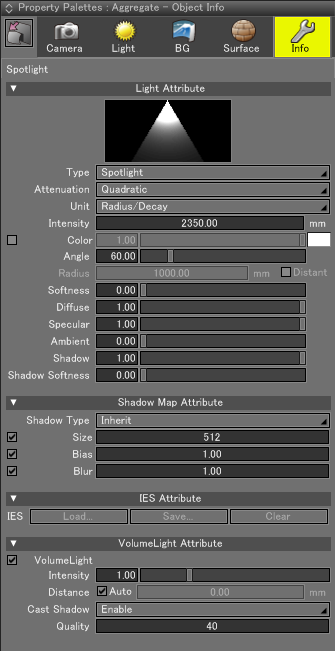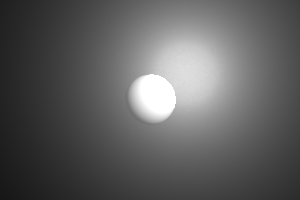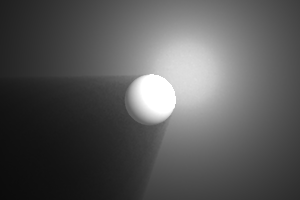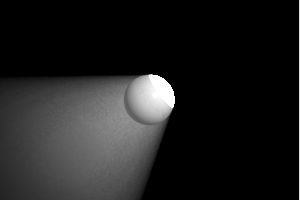Light Information
This information is displayed when a spotlight, point light, directional light, or distribution light data is selected. You can modify settings such as light intensity.

Light Attribute Settings
- Type
- Switch between Point Light, Spotlight, Directional Light, or Distribution Light.
Note Distribution Light is only available in Shade3D Professional.
- Attenuation
- Specifies the method for attenuating the intensity of the surface to be illuminated.
- Unit
- This menu is used to select Radius/Decay or Lumen as the unit to be entered from the Intensity textbox.
If None is selected in the Attenuation popup menu, you cannot set this unit.
Note When the light flux of the Φ Lumen is vertically and uniformly illuminating a uniform diffuser of 1 m2 size, the illuminance of the uniform diffuser becomes Φ lux. When radiosity is used, this illuminance can be used as a measure of intensity of a lighting fixture.
- Intensity
- The light intensity.
If None is selected in the Attenuation popup menu, you cannot set this light intensity. - Color Checkbox
- Specifies the light color setting method.
If unselected, the light will inherit the surface settings.
Selecting this checkbox (on) will set the amount in which a light color is reflected and a light color.
- Color Slider, Textbox, and Color Box
- Specifies the color of light.
Set the amount in which a light color is reflected in the slider or textbox. Set a light color in the color box. If None is selected in the Attenuation popup menu, the light intensity is determined from this value. - Angle
- Available when Spotlight is selected. Sets the irradiation angle of the spotlight. You can specify this irradiation angle with a real number of 0 to 360 degrees.
- Radius
- This textbox becomes active when Directional Light is selected and the Distant checkbox is cleared (off). This box is used to set the cylinder radius when a directional light is used as the cylinder object light.
- Distant
- This checkbox becomes available when Directional Light is selected. Selecting this checkbox will treat the directional light as the distant light.
- Softness
- Available for Spotlight and Directional Light types. For Spotlight, sets the amount in which the contour of the irradiation range blurs. For Directional Light, sets the amount in which the softness effect is reflected toward the inside of the cylinder radius.
- Diffuse
- Specifies the amount in which the light intensity is reflected in the diffuse color of the object. When the value is 0, the light is not reflected in the diffuse color of the object.
- Specular
- Used to set the amount in which the light intensity is reflected in the specular highlights of the object. When the value is 0, the light is not reflected in the specular highlights of the object.
- Ambient
- Specifies the intensity of the ambient light.
Note Different from the distant light, the intensity of the ambient light is not the ratio for the brightness of the light.
- Shadow
- Specifies the shadow darkness. When the value is 0, calculation time is reduced because shadow calculation is not performed.
- Shadow Softness
- Specifies shadow blur.
Note Shadow Softness is available when rendering with Path Tracing in Shade3D Basic and Standard. Shadow Softness is also available with Ray Tracing in Shade3D Professional.
- Shadow Quality
- Specifies the ratio of rendering quality used for the shadows of each light.
See alsoLight Quality
Shadow Map Attribute Settings
These settings affect shadow density and the shadow calculation method.
- Shadow Type
- This menu is used to select Inherit, Ray Tracing, or Shadow Map for rendering shadows.
- Size
- Specifies the shadow map size. If the size is , the contour of the shadow can be clearly represented but more memory is consumed. If the size is small, the shadow may become jagged.
Deselecting this checkbox will inherit the values in rendering settings.
If set to 0, no shadow map is created. - Bias
- Specifies the shadow map bias value. If the object that accepts a shadow map is not parallel, part of the shadow may not display. However, changing the shadow map bias value makes it possible to display a shadow even for an uneven object.
Deselecting this checkbox will inherit the rendering settings. - Blur
- Specifies the shadow map blur amount (for shadow edges).
Deselecting this checkbox will inherit the rendering settings.
IES Attribute Settings
Note IES Attribute settings are available in Shade3D Professional.
- Load...Textbox
- Loads distribution light data.
- Save...Textbox
- Saves the distribution light data.
- Clear Textbox
- Clears the distribution light data.
Volume Light Attribute Settings
These settings affect Volume Lights.
Note Volume Light Attribute settings are available in Shade3D Standard and Professional.
- Volume Light
- When selected, the Volume Light from the light is rendered.
- Intensity
- Specifies the Volume Light intensity. The intensity of the Volume Light to be rendered is obtained by multiplying the intensity of this Volume Light attribute by the intensity of the light attribute.
- Distance
- This textbox becomes available when the Auto checkbox is unselected. This box is used to set the distance that the intensity of the Volume Light reaches. The intensity of the Volume Light becomes 0 at the distance set in this textbox. The radius is displayed by a wireframe sphere size in the Figure Window.
- Auto
- Automatically sets a value twice the intensity of the light attribute as the radius of the Volume Light.
- Cast Shadow
- Select Disable, Enable, or Inverse Volume as the method for casting the shadow of the Volume Light. The Shadow value of the shadow attribute is reflected in the shadow darkness.
- Quality
- Specifies the Volume Light rendering quality on a per light basis.
The Volume Light quality is also linked to Ray Tracing Quality in the Rendering Settings. The quality obtained by adding Ray Tracing Quality and Quality of the Volume Light attribute serves as the quality to be rendered. Improved Ray Tracing Quality is applied to the whole scene, so presence of several lights leads to a reduced rendering speed. If you want to improve the qualities of only some lights, improving the Quality of the Volume Light individually prevents the rendering speed from lowering.See alsoLight Quality


